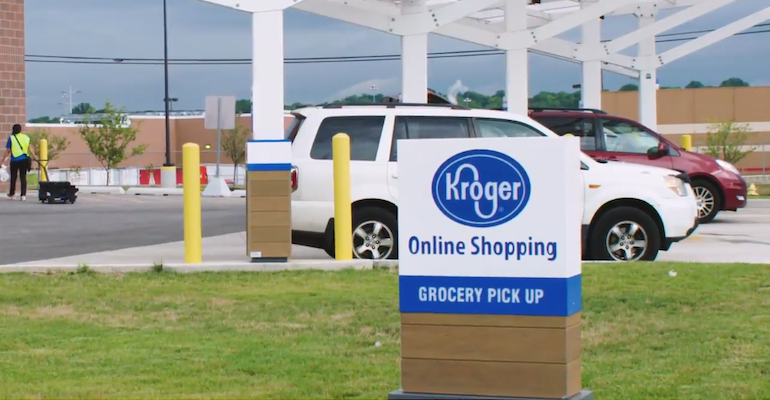Executives at The Kroger Co. said a 92% jump in first-quarter digital sales shows that the supermarket giant’s e-commerce investments are bearing fruit.
Overall sales for the quarter ended May 23 climbed 11.5% to $41.55 billion, with identical sales excluding fuel surging 19%. In a conference call with analysts on Thursday, chairman and CEO Rodney McMullen estimated that digital sales accounted for 6.5% to 7% of Kroger’s total sales in the period.
“Kroger began investing in digital several years ago to build a seamless ecosystem that would deliver anything, anytime, anywhere. As a result, we have over 2,000 pickup locations and 2,400 delivery locations, reaching 97% of our customers, with a seamless customer experience that combines the best of our physical stores with digital,” McMullen said. “These investments were especially timely, as customer adoption of pickup and delivery grew significantly during the pandemic. And because of our existing ecosystem, we were able to respond quickly to further expand and enhance our e commerce services.”
For example, Kroger expanded no-contact delivery and low-contact pickup services as well as contact-free payment solutions, such as Scan, Bag & Go and Kroger Pay, he explained. To support increased volume in pickup orders, the company hired more e-commerce associates, added more order pickup slots, stepped up the frequency of communications with customers and began testing a grocery pickup-only location in Cincinnati, he added.
“All of this contributed to a 92% sales growth in digital channels in the first quarter. In April and May, the sales grew in the triple digits,” McMullen said.
To support increased volume in pickup orders, Kroger hired more e-commerce associates and added more order pickup slots.
According to Chief Financial Officer Gary Millerchip, digital sales contributed slightly more than 3% to identical sales excluding fuel in the first quarter.
“New customer engagement with our pickup and delivery services spiked significantly during the quarter, and we have been encouraged by early customer repeat usage. Digital sales in the second quarter remain elevated, up triple digits in the first three weeks,” Millerchip told analysts. “We continue to invest in digital and offered a fee-free pickup promotion to provide more value for our customers in ways that are most relevant at this time. We were also excited to announce several new enhancements to our digital customer experience, including the launch of our check-in on arrival option for pickup customers and the launch of contactless doorstep delivery.”
Automating with Ocado
Meanwhile, Cincinnati-based Kroger has been moving ahead in building an e-commerce backbone with partner Ocado. Last week, Kroger unveiled plans to build three new Ocado-powered automated customer fulfillment centers (CFCs) in the Great Lakes, Pacific Northwest and West regions. The retailer so far has announced plans for nine CFCs, with the first due to open in Monroe, Ohio, in early 2021.
“We continue to invest in and constantly improve our e-commerce capabilities. Our partnership with Ocado remains an essential part of our evolving seamless ecosystem. Our customer fulfilment centers will accelerate our ability to serve customers seamlessly and in a more cost-effective way,” McMullen said in the call.
Compared with the previously announced CFCs, which range from 335,000 to 375,000 square feet, the new facilities will be smaller. Kroger said the CFCs will measure 300,000 square feet in the West, 200,000 square feet in the Pacific Northwest and 150,000 square feet in the Great Lakes.
“We believe Ocado’s value as a partner is not just its current capabilities, but also in how quickly the company is able to innovate and serve rapidly changing consumer markets. We’re designing a flexible distribution network, combining disaggregated demand and proximity of our stores, medium-size facilities and large-size facilities. You can see this strategy taking shape in the new automated CFCs, which will span a range of sizes,” McMullen said.
“The varying sizes demonstrate the flexibility of the Ocado fulfillment ecosystem to best serve the respective markets,” he noted. “Our network will flex as demand matures and the options will allow us to fulfill same-day or next-day delivery or pickup and customer or store replenishment.”
Kroger also expects the Ocado partnership to help improve the cost/profit equation for online grocery orders. When a customer first switches to online purchases, it typically takes three or four years before that customer’s profitability is the same as their in-store shopping, McMullen explained, but Kroger ultimately ends up getting “a significantly higher share” of that customer’s total household spend. He added that Kroger has seen a lot of new delivery and pickup customers and “nice repeat purchases” from them.
“As that customer continues to give us more of their total share of spend for a household, and as our teams continue to take costs out in terms of serving that customer, and as our Ocado sheds begin to come online and some of the other facilities to supply our customers, we would expect that digital will be a tailwind for us as we move forward,” McMullen said. “And it’s really just the fact that the business basically doubled overnight.”
For our most up-to-date coverage, visit the coronavirus homepage.





